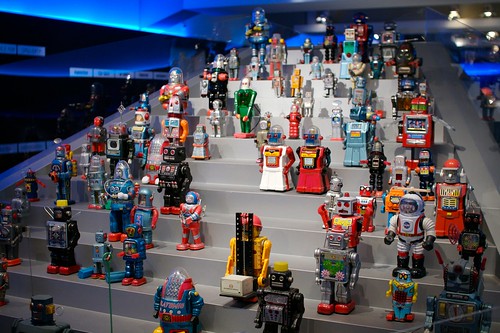 A quick update about the robolift conference program, I've been building over the previous months. The event is in two weeks and I'm looking forward to see the presentations and debates! We finalized the line-up last week and here's the latest version:
A quick update about the robolift conference program, I've been building over the previous months. The event is in two weeks and I'm looking forward to see the presentations and debates! We finalized the line-up last week and here's the latest version:
- The Shape of robots to come: What should robots look like? Is it important that robots look like humans or animals? Are there any other possibilities? What alternatives are offered by designers? With Fumiya Iida (Bio-Inspired Robotics Laboratory, ETH Zürich), James Auger, (Auger-Loizeau) and Dominique Sciamma (Strate College)
- The social implications of robotics: What does it mean for society to have personal and socially intelligent robots? What are the consequences for people? What are the ethical challenges posed by robots that we can anticipate in the near future? With Cynthia Breazeal (MIT Medialab Personal Robots group), Wendell Wallach (Yale University: Interdisciplinary Center for Bioethics) and Patrizia Marti (Faculty of Humanities, University of Siena).
- Expanding robotics technologies: robot hacking, augmented humans and the military uses of robots. As usual with technologies, robots can be repurposed for other kinds of objectives: programmers « hack » them to test new opportunities, the military deploys them on the battlefield, and robotic technologies are adapted to « augment » the human body. What does this mean? What could be the consequences of such repurposing? With Noel Sharkey (Professor of AI and Robotics, University of Sheffield), Daniela Cerqui (Cultural anthropologist, University of Lausanne) and Daniel Schatzmayr (Robot hacker)
- Human-robot interactions: Robots seem to live either in the long-distant future or in the realm of research labs. This vision is wrong and these speakers will show us how nowadays people interact with them in Europe and in Japan. The session will also address how robots can be useful in developing or understanding our emotions. With Frédéric Kaplan (OZWE and Craft-EPFL), Fujiko Suda (Design ethnographer, Project KOBO) and Alexandra Deschamps-Sonsino (Evangelist, Lirec)
- Artificial intelligence: acquired versus programmed intelligence? Artificial Intelligence used a recurring objective of engineering. This session will give an overview of the recent progress in this field and the consequences for robotic technologies: How much pre-programming can you put into robotic intelligence? Can robots learn on their own? With Pierre-Yves Oudeyer (INRIA) and Jean-Claude Heudin (Institut International du Multimédia)
- The Future of robotics: This session will feature two talks about how robots might be in the future. From assistive care products to new forms of interactions, we will see tomorrow's technologies, their usages and applications. With Tandy Trower (Hoaloha Robotics) and Jean-Baptiste Labrune (Lab director at Bell Labs Alcatel-Lucent)
- Debate: Errare Humanoid est? Should robots look like humanoid? How do/will people interact with them? To conclude the conference, we will get back to the topic of the first session and discuss the importance of humanoid shapes in robotic development: Is it necessary? What are the limits and what opportunities? What could be the alternatives? With Bruno Maisonnier (Founder of Aldebaran Robotics) and Francesco Mondada (Researcher in artificial intelligence and robotics, EPFL).
Thanks to all the speakers who accepted to participate!